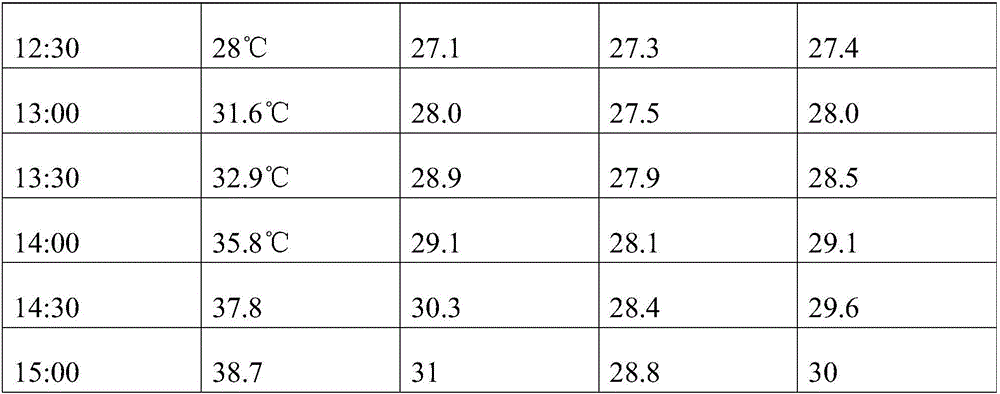Building heat insulation layer material
An insulation layer and building technology, which is applied in the field of building insulation layer materials, can solve the problems of inconvenient building space utilization, high cost of insulation layer materials, and danger of building iron sheds for insulation, etc., and achieves easy promotion and insulation effects. Good, low cost effect
- Summary
- Abstract
- Description
- Claims
- Application Information
AI Technical Summary
Problems solved by technology
Method used
Image
Examples
Embodiment 1
[0019] The active agent takes the following component raw materials in units of g: silicon dioxide 31g, alkali lignin 21g, potato flour 11g, bentonite 7g, fly ash 3g, betaine 11g, dogene 1g and calcium chloride 5g, and then The raw materials of each component are mixed and stirred evenly, and it is ready for use.
[0020] A preparation method of a building heat insulation layer material, the operation steps are as follows:
[0021] (1) Weigh the following raw materials in g: 20g sodium silicate, 10g lime, 5g orientin, 3g porphyrin, 30g wheat straw with a particle size of 1mm, 5g polysaccharide, 6g stearyl phospholipid, hydrogen peroxide 2g and 1g of the spare active agent mentioned above, mix and stir sodium silicate, lime, polysaccharide and active agent evenly, then add orientin, porphyrin, and stearyl phospholipid, mix and stir evenly, and let stand for 10 minutes;
[0022] (2) Add hydrogen peroxide to the substance obtained after standing in step (1), and let it stand for...
Embodiment 2
[0024] The active agent takes the following component raw materials in units of g: silicon dioxide 41g, alkali lignin 31g, flour 21g, bentonite 11g, fly ash 7g, betaine 15g, dogene 3g and calcium chloride 8g, and then each The component raw materials are mixed and stirred evenly, ready to be prepared and set aside.
[0025] A preparation method of a building heat insulation layer material, the operation steps are as follows:
[0026] (1) Weigh the following raw materials in g: 30g sodium silicate, 20g lime, 9g orientin, 5g porphyrin, 40g wheat straw with a particle size of 1.5mm, 11g polysaccharide, 9g stearyl phospholipid, Mix 4g of hydrogen peroxide and 3g of the spare active agent mentioned above, mix and stir sodium silicate, lime, polysaccharide and active agent evenly, then add orientin, porphyrin, and stearyl phospholipid, mix evenly, and let stand for 20 minutes;
[0027] (2) Add hydrogen peroxide to the substance obtained after standing in step (1), and let it stand ...
Embodiment 3
[0029] The active agent takes the following component raw materials in units of g: silicon dioxide 36g, alkali lignin 26g, tapioca flour 16g, bentonite 9g, fly ash 5g, betaine 13g, dogene 2g and calcium chloride 6g, then The raw materials of each component are mixed and stirred evenly, and it is ready for use.
[0030] A preparation method of a building heat insulation layer material, the operation steps are as follows:
[0031] (1) Weigh the following raw materials in g: 25g sodium silicate, 15g lime, 7g orientin, 4g porphyrin, 35g rice straw with a particle size of 1.3mm, 8g polysaccharide, 8g stearyl phospholipid, Mix 3g of hydrogen peroxide and 2g of the spare active agent mentioned above, mix and stir sodium silicate, lime, polysaccharide and active agent evenly, then add orientin, porphyrin, and stearyl phospholipid, mix evenly, and let stand for 15 minutes;
[0032] (2) Add hydrogen peroxide to the substance obtained after standing in step (1), and let it stand for 35 ...
PUM
| Property | Measurement | Unit |
|---|---|---|
| Granularity | aaaaa | aaaaa |
| Granularity | aaaaa | aaaaa |
| Granularity | aaaaa | aaaaa |
Abstract
Description
Claims
Application Information
 Login to View More
Login to View More - R&D Engineer
- R&D Manager
- IP Professional
- Industry Leading Data Capabilities
- Powerful AI technology
- Patent DNA Extraction
Browse by: Latest US Patents, China's latest patents, Technical Efficacy Thesaurus, Application Domain, Technology Topic, Popular Technical Reports.
© 2024 PatSnap. All rights reserved.Legal|Privacy policy|Modern Slavery Act Transparency Statement|Sitemap|About US| Contact US: help@patsnap.com









